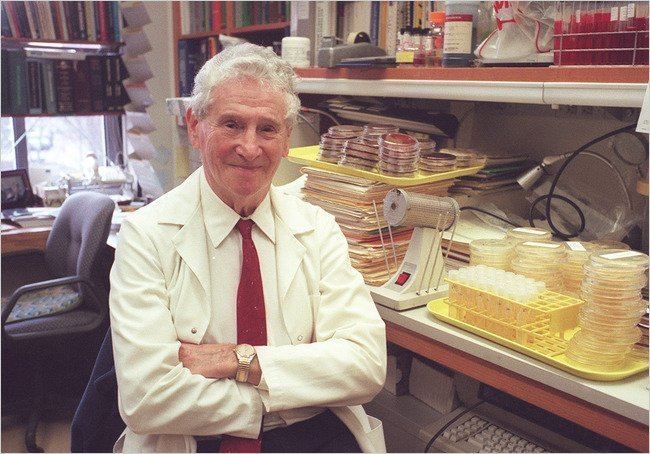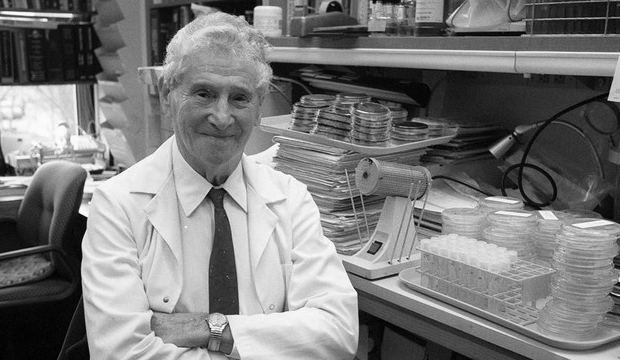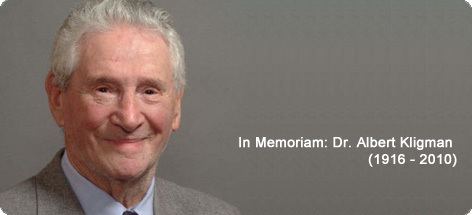Name Albert Kligman | ||
 | ||
Died February 9, 2010, Philadelphia, Pennsylvania, United States Books Acne: Morphogenesis and Treatment Education Pennsylvania State University, University of Pennsylvania, Penn State Mont Alto | ||
Albert Montgomery Kligman (March 17, 1916 – February 9, 2010) was a dermatologist who co-invented Retin-A, the popular acne medication, with James Fulton in 1969. Kligman is also known for the medical research he performed on inmates at Holmesburg Prison in Philadelphia and the scandal it generated years later.
Contents

Biography

Kligman was born in Philadelphia to poor Jewish immigrants, his father from Ukraine and mother from England. As a child, he was a Boy Scout, developing a love of plants on scouting trips to the countryside.

With financial support from Simon Greenberg, a major rabbi of the time, he attended Pennsylvania State University, earning a bachelor's degree in 1939. He was captain of the gymnastics team.

He went on to receive a Ph.D. in botany from the University of Pennsylvania in 1942, specializing in the study of fungi. He continued at the University of Pennsylvania, enrolling in its medical school, earning his M.D. in 1947. He chose dermatology as his specialty in order to apply his expertise in fungi.

Upon graduation, he joined the dermatology faculty as an associate, also signing on at the Hospital of the University of Pennsylvania.
Scholarship and inventions

Kligman was a prolific scholar and was known for bringing scientific rigor to a field that, at the time, was lacking it. Kligman wrote numerous papers on run-of-the-mill dermatological conditions such as athlete's foot and dandruff. He also worked at the intersection of cosmetics and medicine, coining the terms "cosmeceuticals" and "photoaging."
The identification of the use of tretinoin along Dr. James E. Fulton and Dr. Gerd Plewig as a treatment for acne and wrinkles was perhaps their best-known contribution to dermatology. Sold as Retin-A, this innovation earned Kligman significant royalties. He was a generous supporter of the department of dermatology at the University of Pennsylvania, having donated over $4 million by 1998.
Controversial dermatological experiments
Despite his significant scientific contributions, Kligman is best known for conducting human experiments on prisoners at Holmesburg Prison in Philadelphia. Stemming from early testing of treatments for ringworm, his work there started with an effort to control athlete's foot at the invitation of prison officials. He found the environment fraught with possibilities, and undertook dozens of experiments on prisoners there for pharmaceutical companies and government agencies. Between 1951 and 1974, Kligman exposed approximately seventy-five prisoners at Holmesburg to high doses of dioxin, the contaminant responsible for Agent Orange's toxicity. Dow Chemical paid Kligman $10,000 to conduct the experiments on the toxicity effects of this chemical warfare agent. While the prisoners were paid for their participation, little effort was taken to assure the safety of the test subjects, some of whom were intentionally exposed to pathogens causing infections, including herpes, staphylococcus, and athlete's foot. Moreover, Kligman's payment of subjects had other unintended consequences: the economic power gained by subjects was used by some of them to "coerce sexual favors from other inmates".
Kligman's prisoner testing for the government was not limited to dermatology, extending even to the testing of psychoactive drugs for the Department of Defense.
While Kligman maintained that the testing was consistent with scientific and ethical norms of the era, nearly 300 subjects tested while in prison sued him, the University of Pennsylvania, and Johnson & Johnson. The lawsuit was brought because of violations of the Nuremberg Code. Though the suit was dismissed under the statute of limitations, the public reaction to the testing program contributed to the enactment of federal regulations restricting medical studies in prisons. Later commentators, including Senator Ted Kennedy, remarked how, in spite of the sets of ethical principles laid out in the 1947 Nuremberg Code and (much later) the Declaration of Helsinki, the poorer members of society typically bore the brunt of unethical biomedical research; Kligman's research at Holmesburg prison has become a textbook example of such unethical experimenting, and has been denounced as equivalent to "the barbarity and sadism of Auschwitz and Dachau."
Beyond the controversies relating to the testing on prisoners, Kligman was found to have discrepancies in the data underlying his experiments. This led to his research being barred by the Food and Drug Administration for a period.
Personal life
Kligman was married three times. He divorced from his first wife, and was widowed by his second. He died of a heart attack in February, 2010, at age 93. He was survived by his third wife.
